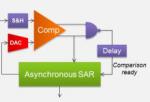D&R Industry Articles (March 2014)
Articles for the Week of March 31, 2014

Plug-n-play UVM Environment for Verification of Interrupts in an IP
This paper proposes a method to mimic the actual behavior of the embedded processor for interrupt handling in standalone IP verification environment. Use of UVM components done to make a reusable, parameterizable and real time interrupt handler for UVM testbench. The method proposed in this paper describes an automated interrupt handler logic which runs parallel to entire environment.Articles for the Week of March 24, 2014

Reusable Test-Case Methodology for SoC Verification
This paper proposes a novel Test-Case methodology for System on chip (SoC) Verification in order to achieve high levels of reusability. It surveys the challenges of a traditional SoC Test-Case Methodology and then proposes a solution.- On-Chip Interconnect Costs Spawn Research
- SoC interconnect architecture considerations
- A systems approach to embedded code fault detection
Articles for the Week of March 17, 2014

Using IP-XACT Metadata for a TLM Modeling Flow
A metadata driven methodology allows automatic generation of netlists and design IP skeletons from a central database that contains registers, ports, interfaces, and other common design data. IP-XACT is commonly used to store the metadata. This paper explores how to use IP-XACT to represent the necessary data to generate SystemC/TLM netlists and components- Big Data: Where It Comes From, Where It Will Go
- Overcoming FPGA board design challenges
- PCI Express vs. Ethernet: A showdown or coexistence?
Articles for the Week of March 10, 2014

Forward-Looking SoC-based PHY Architecture for Macro and Small Cell LTE eNode-Bs
This paper describes an efficient, forward-looking architecture that enables handling of various form factors of LTE base stations with minimal software modification and without architecture changes. The architecture proposed allows easy migration to the next generation SoCs as well as to more powerful SoCs of the same generation. Our implementation of this architecture has now migrated two generations of SoCs for LTE Release 9 small and macro cells, and is ready for migration to a multi-sector, LTE-A macro base station.- Zynq design from scratch
- Challenges associated with Digital-Analog combined IP's
- Using domain-specific modeling languages for medical device development
- Using model-driven development to reduce system software security vulnerabilities
Articles for the Week of March 3, 2014

Scalable Architectures for Analog IP on Advanced Process Nodes
This paper elaborates on how ADCs can work with Moore's Law to move with the power and area scaling trends that are common for digital circuits. It will compare the main ADC architectures and conclude that the Successive-Approximation Register (SAR) based ADC is very well positioned as the architecture of choice for medium- and high-speed ADCs in modern SoCs, especially in 28-nm processes and beyond. It will describe implementations of the SAR ADC architecture that reduce power consumption and area usage dramatically, enabling SoC designers to successfully integrate these analog components in their next SoCs.- Understanding sigma delta ADCs: A non-mathematical approach
- Using static analysis to detect coding errors in open source security-critical server applications
- Smaller scale chip design relies on creative thinking and collaborative workflow
- The Next-Generation Cellular Network Takes Shape
- Timing-Driven Hybrid RTL/Gate Partitioning for Predictable FPGA-Based Prototyping
- The hardware (and software) implications of endianness








